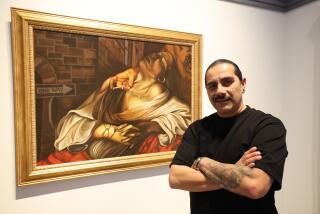Everyday objects turn to art in Scoli Acosta’s hands
“The aesthetics of resourcefulness” is a phrase that Scoli Acosta has often used to describe his wide-ranging artwork, which includes sculpture, installation, drawing, painting, photography, video and performance. It is equally applicable to the Echo Park apartment that doubles as his studio.
The stairs and landing outside his door are lined with small, potted cotton plants, from which he hopes to gather enough cotton to one day make a T-shirt (after going to India to learn how to make a spinning wheel). His furniture is gently refurbished secondhand fare; his curtains a lovely hand-stitched patchwork. The kitchen table is dotted with flowerpots he’s made by hollowing out found bricks. “I enjoy using my hands,” he says. “I like to see how things are made and to accentuate the handmade.”
Thirty-eight years old and slight of frame, Acosta has a sheepish but subtly theatrical demeanor that gives every conversation the feel of a performance. Though he grew up in Lincoln Heights and Baldwin Hills, he lived in Europe on and off through his 20s, speaks French, some German and some Spanish, and maintains a somewhat self-conscious relationship to English, his diction intermittently formal and colloquial. He is fond of reciting poems from memory and does a wonderful reading of “As Above, So Below,” a children’s book (yet unpublished) that he made in collaboration with writer Joseph Mosconi.
In discussing his work, however, he is tentative and occasionally uneasy, as if hesitant to craft a verbal narrative for what is a highly organic and associative process. His installations — tidy arrangements of lovingly crafted, often colorful objects, many of them vaguely recognizable (a floral chandelier, a shopping bag, a brick) but cast in odd, illogical arrangements — feel like rooms transported from some other world, where the rules are similar but different from ours. Whimsical and elegant, they seem to set their own terms, deflecting interpretation.
“I think about the work more as poetry,” he says. “I like it to have this room to breathe.” His process is one of meandering absorption, his work the outgrowth, in many cases, of his interactions with a particular place. The photographs, videos and sculptures that appear in “Rippling: An Earnest Moire Effect,” for instance, a recent small solo exhibition at the Armory Center for the Arts in Pasadena, were conceived on a residency last fall in Carquefou, France. (Though not currently represented by a gallery in L.A. — most of his shows here have been in museums and nonprofit spaces — he’s shown extensively in Europe.) “I enjoy going into specific situations and putting together the information around me,” he says. “Finding my place inside of that environment, creating these small cosmologies out of really specific elements that are attractive to me for some reason.”
The effect of this particular environment was strikingly evident in an email he sent midway through the two-month residency. When he spoke shortly before his departure, he’d been painting on canvas for the first time since high school and had just completed a series of 10 small monochrome paintings, each in the shape of a pentagonal tambourine. He’d pointed out the details of the paintings’ craftsmanship with pride, from the handmade stretcher bars to the flattened bottle cap jingles, but sounded oddly unconvinced by his account of the work’s conceptual underpinnings.
In the email, however, his excitement was palpable. He’d been at a crossroads, he wrote, with the pentagonal paintings, “poking around in some weird formalist stuff I’m not accustomed to thinking about and don’t really have a grip on either.” He was enchanted, however, by the French countryside. He’d never seen so many wild mushrooms. A circus had come to a nearby field. “The hoot of the owl was replaced by the lion’s roar,” he wrote. “The animals were on chains staked to a central point and would eat circles out of the fields. The circles multiplied every day as they were moved to new spots. It was beautiful. I started tracing the circles in flour and taking photos from above by throwing my camera in the air.”
He did continue to paint but abandoned the weighty mantle of the monochrome for the looser, more playful figurative style of his drawings. He also wandered the landscape, taking photographs and videos. He photographed the circles that the animals formed in the grass, then the circling ripples in a puddle. He sank his camera to the floor of a tide pool on the beach, threw pebbles across the surface and recorded the ripples from below. He cut huge, concentric circles from a roll of black carpet that had been left in his studio, dragged them onto the grass and took aerial photographs by spinning his camera over his head. He cut circles out of canvas, then tossed them into the air and photographed them from below.
The charm and vitality of the work that resulted, like that of Acosta’s other memorable installations in recent years — in the Los Angeles County Museum of Art’s “Phantom Sightings” in 2008 or “Bountiful,” his solo show at LAX Art the same year — stem in part from his insistence on maintaining transparency, on laying bare both the craft and the enchantment.
“It’s about bringing attention to the mechanics of the piece,” he says. “Normally, something is considered well made when you can’t see how it’s done. I think the way that I work flips that idea around. Even though you can see how it’s made, the mechanics of it, it still has a beauty and a magic to it. I love that. Everything is such junk these days, it’s really depressing. There’s a real exchange that happens when you make something, when you use your hands. You create the world.”
More to Read
The biggest entertainment stories
Get our big stories about Hollywood, film, television, music, arts, culture and more right in your inbox as soon as they publish.
You may occasionally receive promotional content from the Los Angeles Times.






